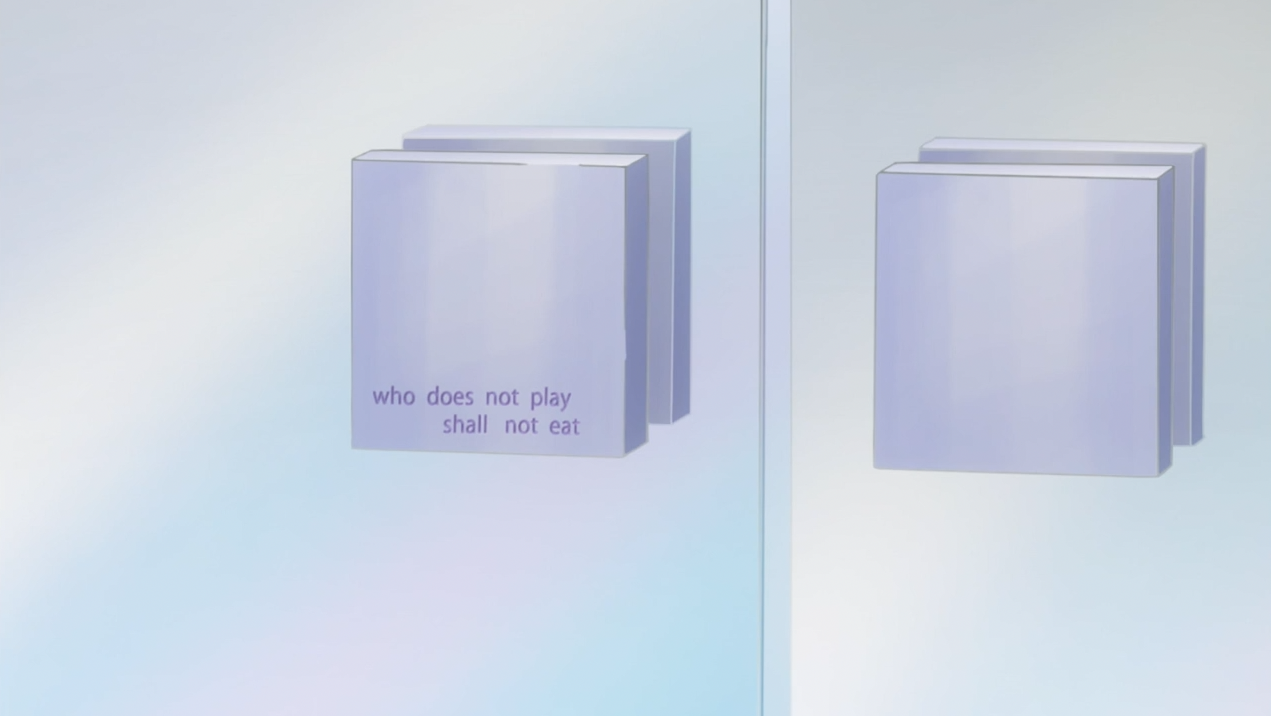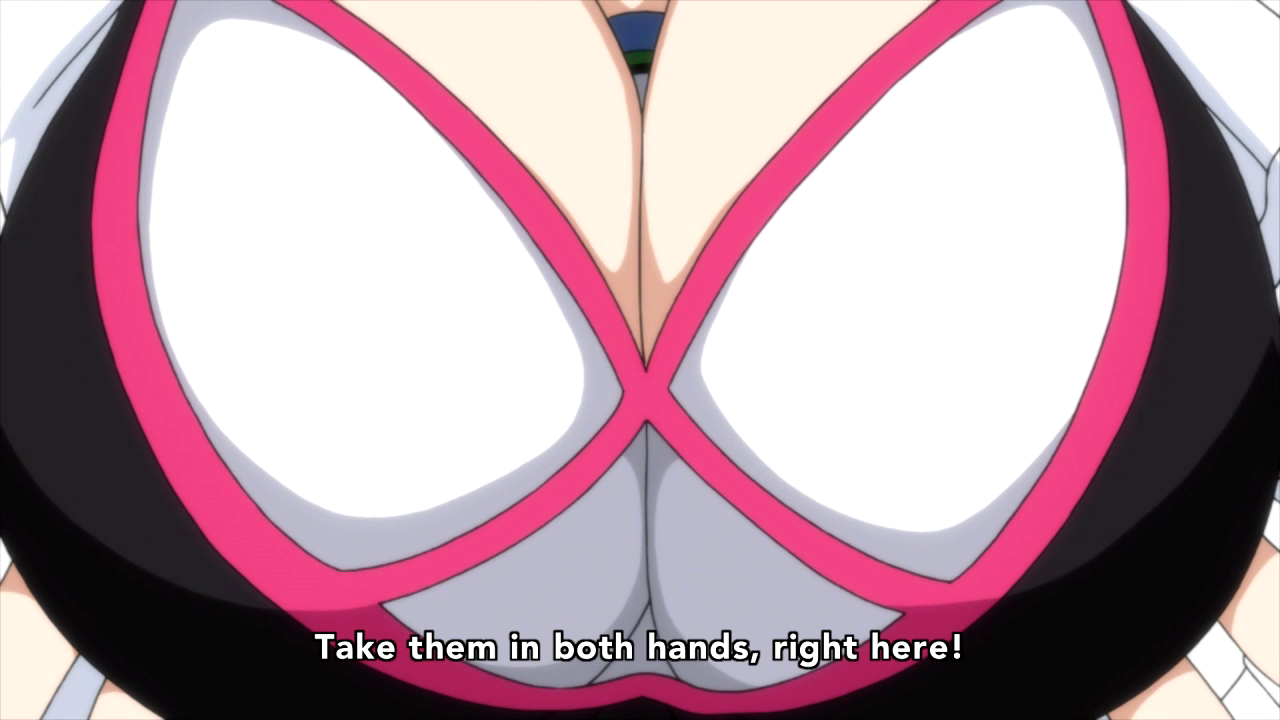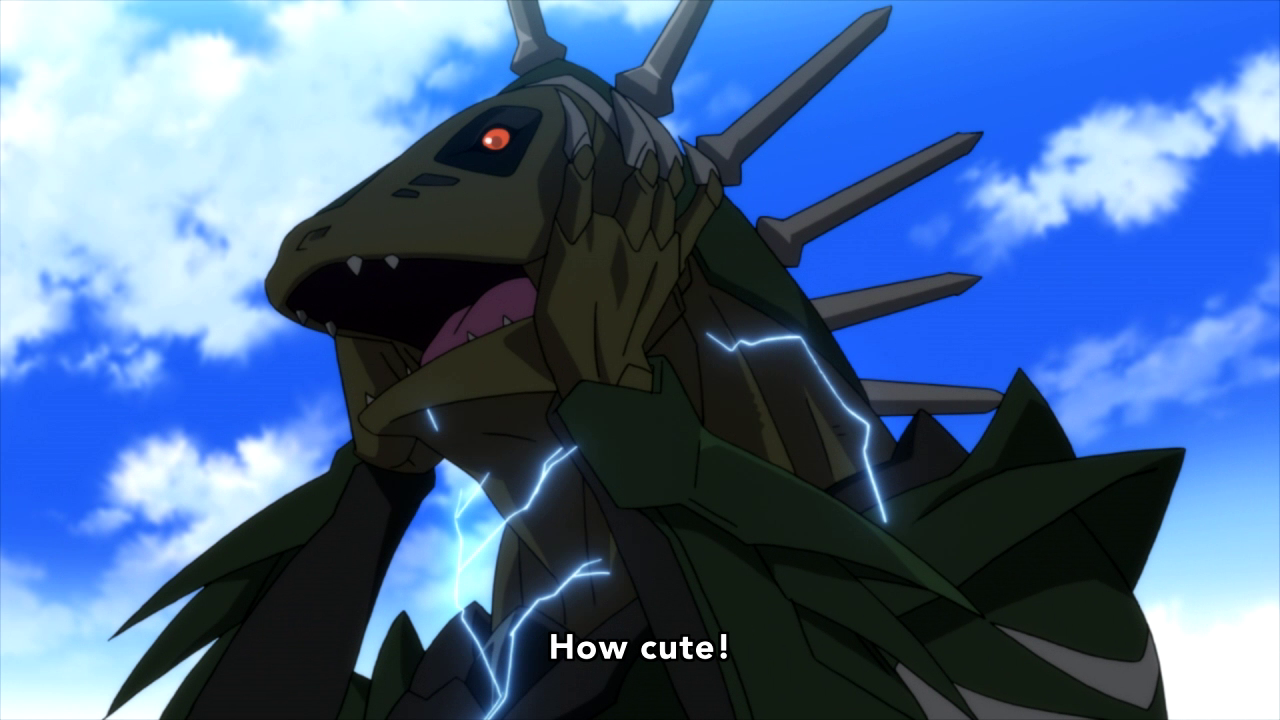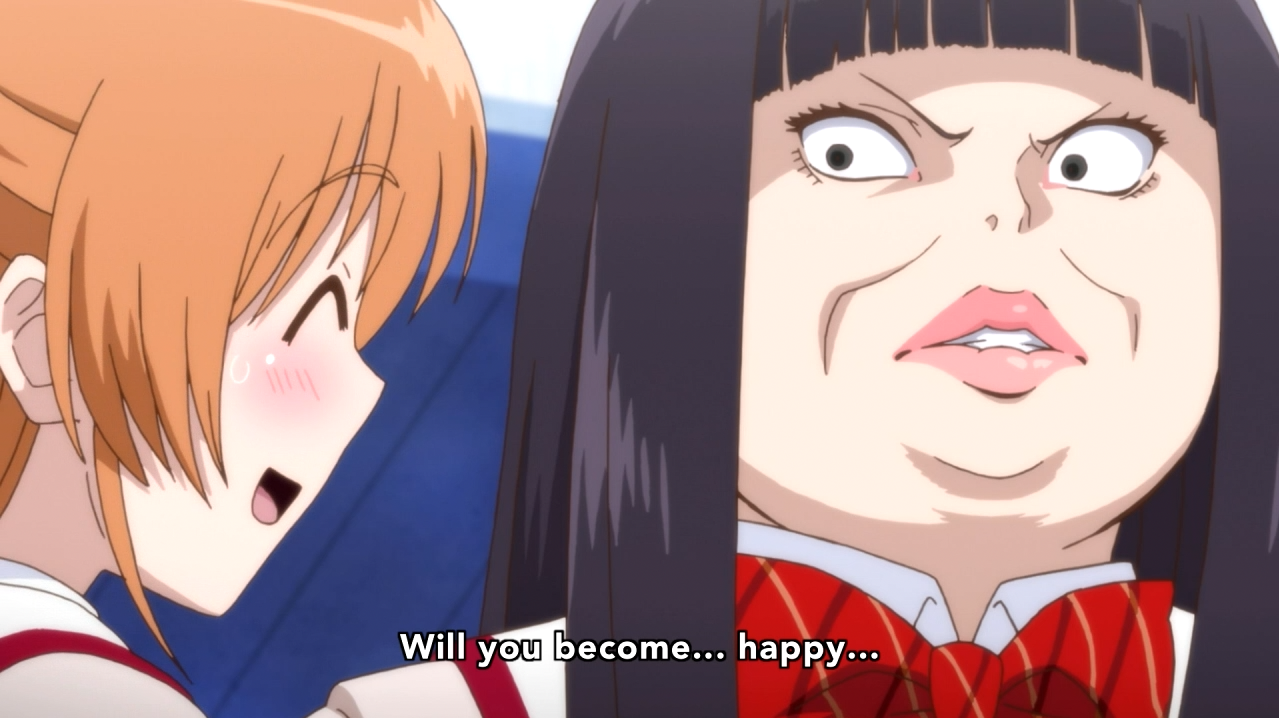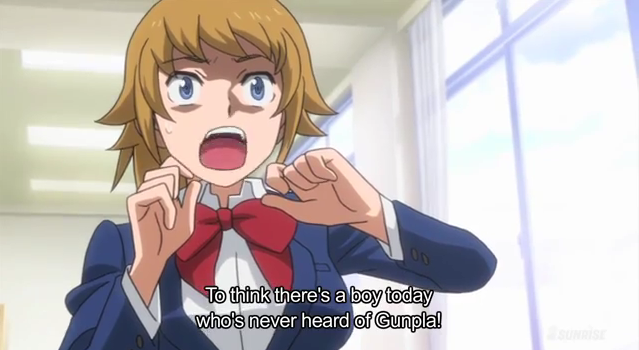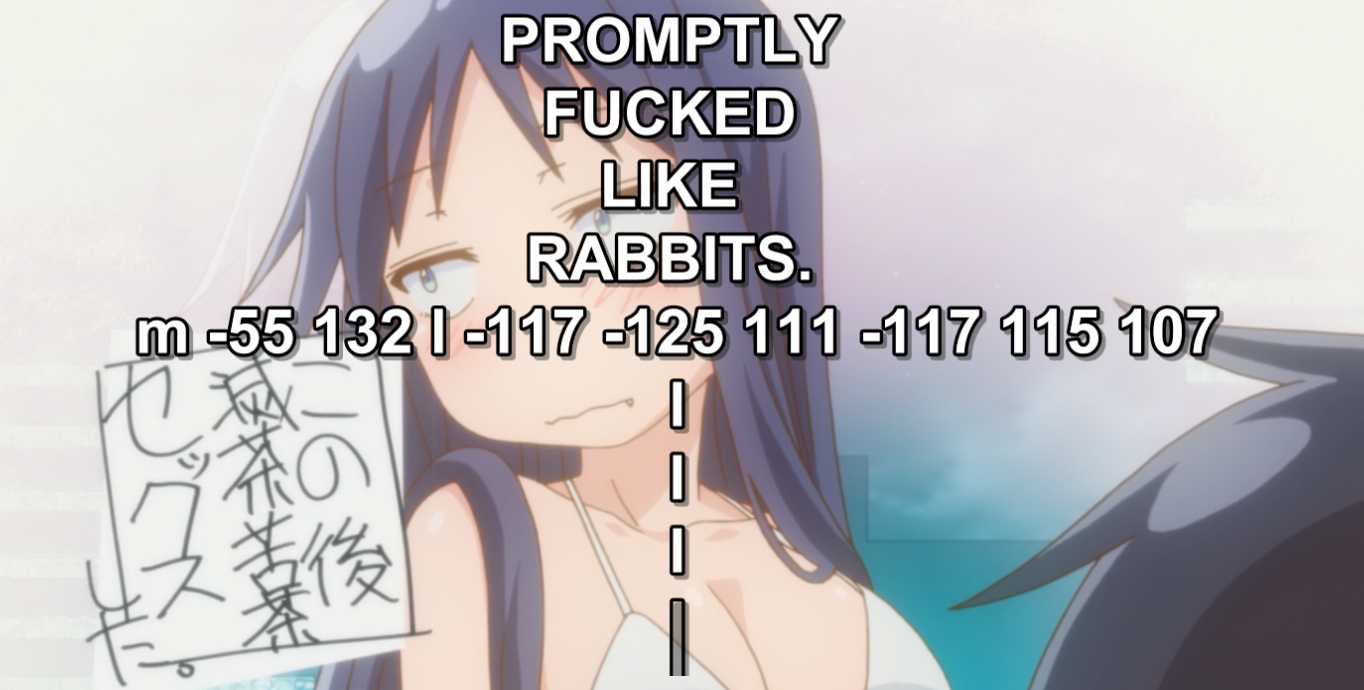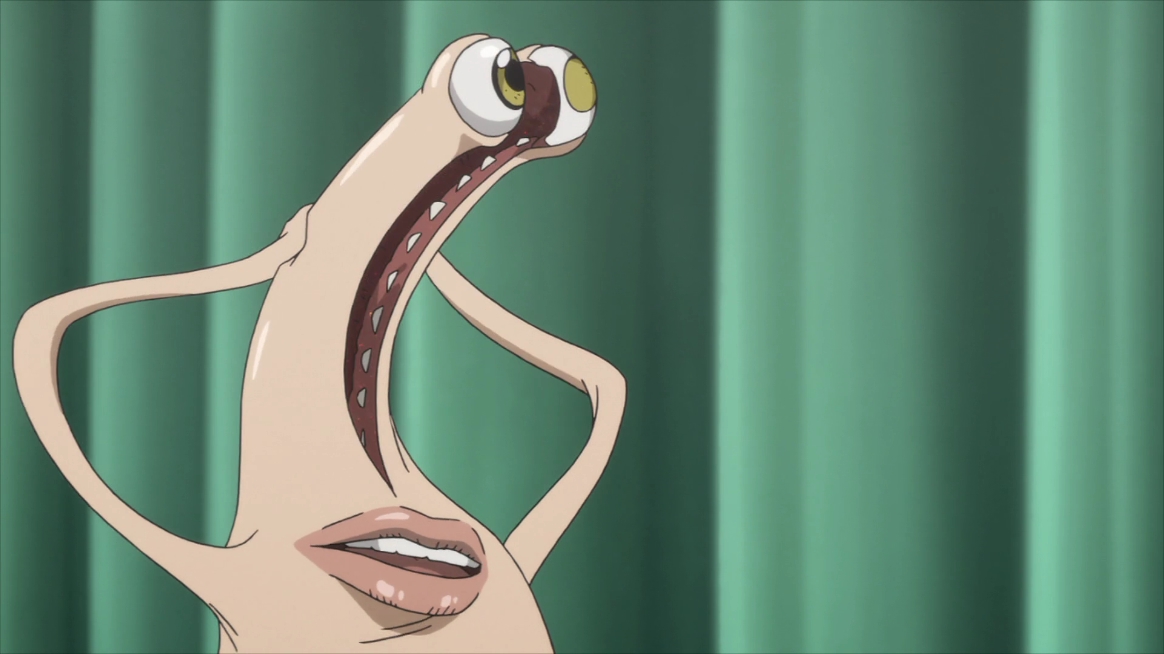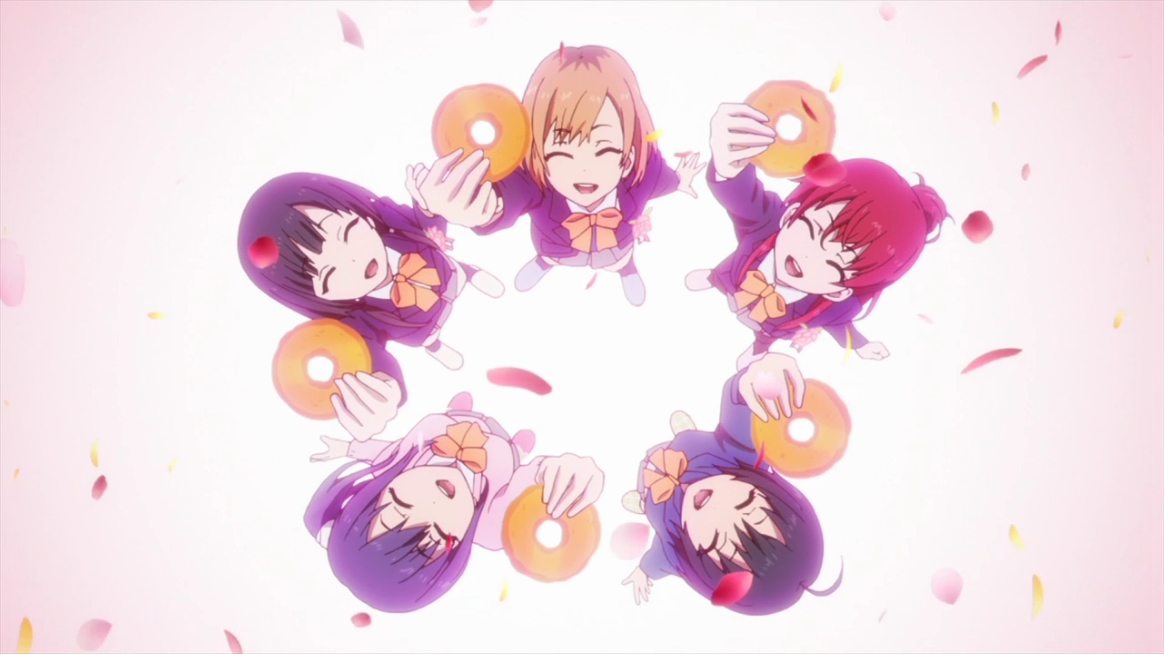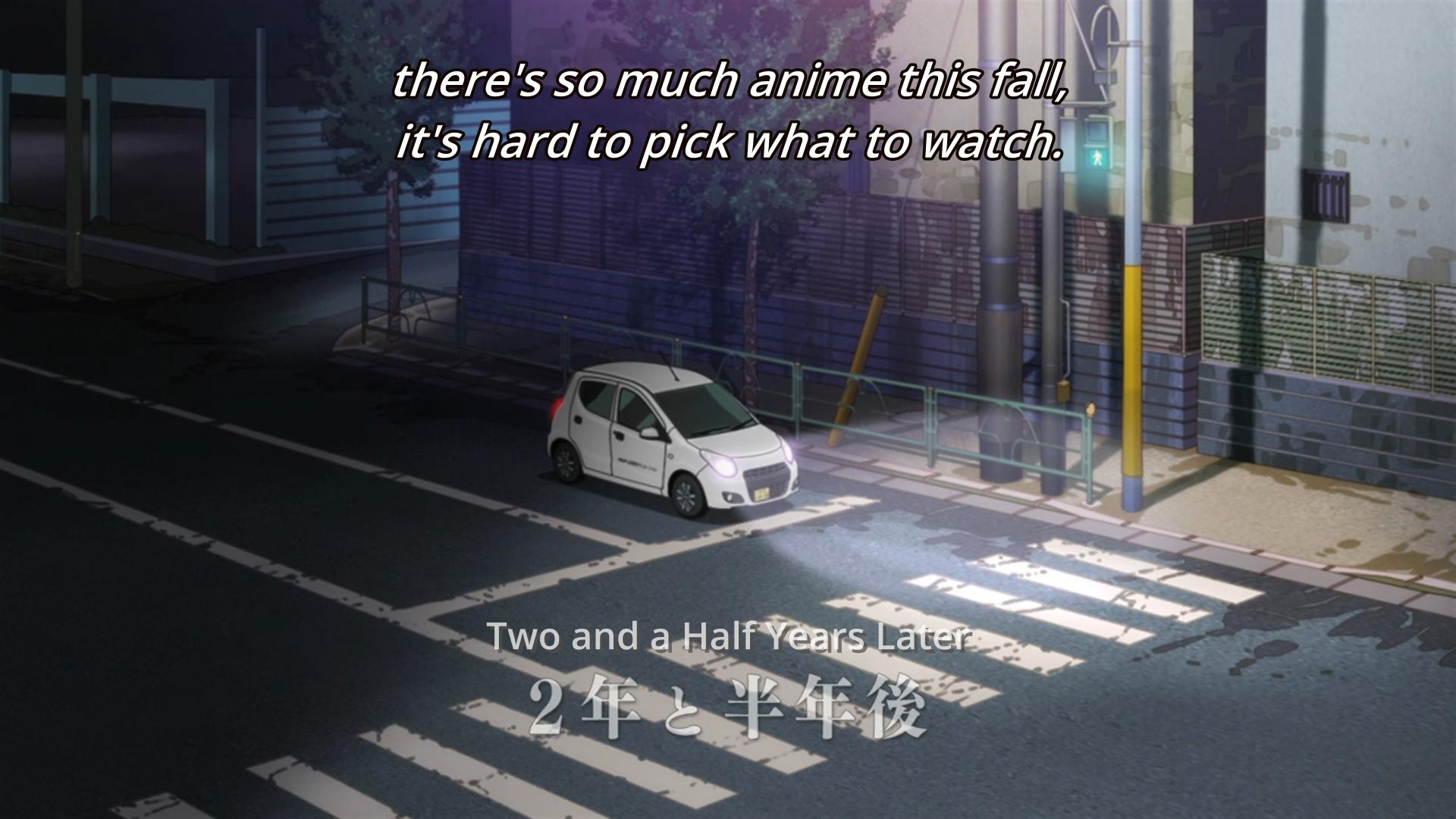10.16
Girl Friend Beta
This anime is literally just cute girls doing cute things, even more so than past efforts such as K-On!. While previous works in the same vein at least attempted to employ other aspects such as humor to keep the viewer’s attention, this is not so in Girl Friend Beta. This episode is 24 and a half minutes’ worth of moe schoolgirls either attempting to talk to each other without falling over or adorably doing things that vaguely resemble academic activities. It’s about as tedious to watch as an anime can be.
There is no conflict. There are no jokes. There aren’t even any real characters in the traditional sense. The “plot” basically amounts to a series of wild goose chases in which the protagonist tries to return a photograph without forgetting how to walk and breathe simultaneously. This is like test footage someone shot at their school upon initially borrowing a camera from their film instructor. Thankfully, it’s not creepy, and it doesn’t feel voyeuristic… granted, it doesn’t really feel like anything, but at least that’s a plus.
The production work on this show is fairly standard. There aren’t really any noticeable problems with the animation or anything, though I must say that – even as someone who doesn’t speak Japanese – Mochizuki’s voice acting is noticeably bad. She doesn’t have many lines, but the ones she does have feel like they’re being read directly from a script over the phone. I have nothing else to say about any aspect of this episode.
I am completely dumbfounded by the existence of Girl Friend Beta. What is its purpose, and why was it made? These are questions that will certainly haunt me to the end of my days. But you know what? If you like this kind of show – and I’m sure you already know if you do – I’m not going to hold that against you. Please, watch and enjoy Girl Friend Beta. I will probably never understand the appeal behind anime like this one, but if you do, then that should be good enough for all of us. — Foggle
Second Opinion!
Well, this was a surprise out from left field. I thought that this was going to het-harem show #3217, but nope that doesn’t seem to be the case, if going by the premiere. it mostly serves as an introductory piece for the characters, which at this point seem to be a bevy of high school cuties. From our rather plain looking female lead Kokomi, her gymnast teammates, the pink haired sensei, a blonde girl quick to take some photos of our lead cutie, another blonde girl Chloe who’s a French cutie, the Kaichou and radio DJ, the quiet librarian and practically all anime schoolgirl stereotypes in anime ever make an appearance for this show. Only at the end does anything occur as Kokomi and Chloe make a pinky promise and a wonderful friendship has started.
Aside from that, not much else takes place. It is all really cute, laidback SoL series at the moment. The character designs are a bit too cutesy for my liking, but it is to be expected. Art and animation are also a bit generic and unremarkable. Overall, its fairly safe, inoffensive and rote girly SoL show with some hinting at possible yuri/shoujo-ai content. I am proceeding with this show, but only cautiously. But still, it’s a pleasant surprise. — The Eclectic Dude
Gonna Be the Twin-Tail!!
From the director of Oreimo comes She-Zow the anime, except this version doesn’t have a message and is completely soul-crushing to watch. Every minute I spent viewing Twin-Tail!!, I could feel my brain cells continuously committing suicide one by one. I’m under the impression that whoever wrote the script for this anime spent 90% of his time in the writing room huffing paint thinner and watching reruns of Go-Onger, which is totally Lord Dalek’s favorite sentai series and you should definitely tweet him about it a lot.
When General Scales from Star Fox Adventures attacks Japan with intentions to destroy the twin-tail hairstyle forever, it’s up to high school hair-fetishist Souji Mitsuka to transform into a little girl with superpowers and take him down. But before he can do this, boobs are thrust in his face. Nothing else happens in this episode. It’s unfortunate that, while this synopsis certainly sounds like it could make for an idiotic but hilarious comedy series, the humor completely failed to resonate with me at all. I found myself cringing constantly, wondering why and how this anime was even produced in the first place. Not since the second cour of Samurai Flamenco has a superhero parody managed to fall so flat for me.
The fight scene at the end of Twin-Tail!!‘s premiere is kind of funny, I guess, and the dinosaur dude managed to make me crack a smile at times, but the overall sense of humor is so stupid that I simply could not bring myself to laugh at any point. I normally enjoy “so bad it’s good” shows, but I honestly feel like this one might be a bit too self-aware. Yes, it’s obvious that this is intentionally vapid, meritless tripe, but that just takes all the fun out of it. For instance, I love High School DxD because, in spite of its dire legitimate attempts at comedy, it so desperately wants you to take its main storyline seriously; it never winks at the audience, and it isn’t smart enough to, which is precisely what makes it so funny. And sure, it’s possible to successfully manufacture that same feeling, but then it has to be really over the top to work, as in spring’s Daimidaler. Twin-Tail!! has the ridiculous ideas it needs to be humorous, but it lacks the earnest execution required for the silliness to come across well, so instead it just ends up being boring and grating.
Perhaps the first half of this episode soured me on what was to come. The second half definitely has moments that I might have found enjoyable under normal circumstances, but that bit where Maaya Uchida’s character kept shoving her breasts in Souji’s face was the closest I’ve seen an anime come to anti-humor in a while, so maybe I would have appreciated the abject stupidity of the final battle more if I’d had enough patience left to laugh at it. My main problem with this anime is that it doesn’t seem to embrace its inherent stupidity enough. It teeters on the brink of being hilarious, but it feels like it’s held back by its own inhibitions, often not willing to go far enough to make the jokes actually funny. It’s more dull than it is charming, and that’ll stop any parody dead in its tracks. — Foggle
Second Opinion!
Naruhisa Arakawa is a contradiction of a writer. In many ways he’s the reverse Yasuko Kobayashi in that in live action he’s written arguably the greatest Kamen Rider series in the last 25 years, Kamen Rider Kuuga as well as the fan favorite sentais Dekaranger and Gokaiger. Whereas in anime however, his track record is not so much spotty as it is down right abominable. This is the man who gave us shows like Listen to Me Girls, I am Your Father; Yosuga no Sora, So I Can’t Play H, and…ugh…Outbreak Company. So to see his name attached to Wanna Be The Twin-Tail!! is more than just a mere cause for alarm. Its not like the premise filled me with any confidence when it was announced. Its the story of a vapid otaku with a fetish for lolis with the twin-tail hairstyle every fucking anime girl has who gets the magic (and humiliating) ability to transform into the girl from Vividred Operation. Totally something that would be dumped at the end of the year and be immediately forgotten…
…and up until the eyecatch, it is that show. There is literally nothing to see with this tired pandering pap smear of a show. Its just a miserable waste.
BUT THEN! Something absolutely magical occurs. You see there’s one more live action show of Arakawa’s I have not yet mentioned. That, my friends, is the great Unofficial Sentai Akibaranger. In that show, a bunch of daydreaming delusional OCD morons are turned into “sentai” by a slightly unhinged woman played by Maaya Uchida. In this show, a daydreaming delusional OCD moron is turned into an over the top, ultracliched, Symphogear reject by an incredibly unhinged woman voiced by…wait for it…Maaya Uchida! Now that might just be a mere coincidence, but then…the villains show up. An evil space empire staffed by late-2000’s Toei rejects and Kamen Rider mooks who want to conquer the universe by stealing that precious twin-tail hairstyle. How do they plan to do this? By hitting schoolgirls in the head with stuffed animals, that’s how! It is at this point that you realize that you’ve been trolled so hard. That Arakawa wanted you to think that it was that crappy high school obssession shlock show before pulling down the curtain to reveal it was Akibranger Season 3. When the evil boss lizard guy starts gets all erogeneous over Tail-Red’s ridiculous do before getting blown to smithereens in classic sentai fashion, I can’t help but laugh at it. It’s brilliant.
So this is my problem. The first half of this show is utter shit, completely irredeemable. The second half is just sheer beautiful insanity designed to hit you over the head with a frying pan. Happily the preview for next week’s episode suggests its going to be more the former than the latter but I’m still unsure about where this is going to go in the longrun. At the moment Wanna Be The Twin-Tails gets a much surprised out of left field partial recommendation from me as long as you’ve watched a ton of episodes of Goseiger and know what to laugh at. — Lord Dalek
A Good Librarian Like A Good Shepherd
If I had to choose only one word to describe A Good Librarian Like A Good Shepherd (henceforth referred to by the shortened Japanese title, Daitoshokan), it would be “average.” The writing is average. The characters are average. The art style is average. The animation, voice acting, and soundtrack are average. Indeed, nothing about this show is particularly good, but at the same time, nothing about it is genuinely bad. It’s filled with cliches, and isn’t that interesting to watch, but I can’t say I loathed the time I spent looking at this first episode either. It’s one of those series that you know is going to be nothing special, but you also can’t bring yourself to hate. That said, I can certainly see this being a fun time waster for slice of life fans, even if I can’t really picture anyone considering it to be essential viewing.
While I struggle to think of anything substantial to say about the content of this episode – it’s so plain that my thoughts fail to extend past what I wrote in the previous paragraph, – I will at least give the writers a little credit for how one of the plot elements ended up playing out. Naturally, Daitoshokan has one of those insipid “sorry, I was trying to save you from certain doom but I accidentally groped you in the process” scenes because, well, of course it does. These are always worth a groan or five, but I must say that this anime somehow found a way to make the aftermath of it a little bit interesting. Sure, the girl ended up not thinking it was a big deal, either because she understood what the protagonist was attempting to do or because she somehow enjoyed it (the latter of which would be incredibly stupid and potentially offensive unless handled well), but what led up to that reveal is something I’ve always wanted to see: the main character was actually ostracized by the other students for doing this. It’s played for laughs, and resolved within 15 minutes, but it’s nice to see someone not so easily forgiven by society for what can only be described as public molestation. Now can we please finally kill this awful cliche and bury it 50 feet underground in a steel container? Thanks.
Overall, I neither liked nor disliked Daitoshokan. That minor subversion I just mentioned aside, nothing about this episode was particularly notable; though like I said at the start, there also isn’t anything I’d say was legitimately poor about it. I think it could potentially hit the right notes for certain people, so it might be worth checking out if the premise interests you at all, but the rest of us will find little reason to care about this show either way. — Foggle
Gundam Build Fighters Try
It’s been seven years since the first Gundam Build Fighters, and the Gunpla Battle Club formed after Iori Sei’s victory at his alma mater has fallen on hard times, with all efforts to repeat his accomplishment torpedoed at the first round of the national tournament. Fumina Hoshino, the sole remaining member of the club, is in need of some help if she wants to keep the club intact and get another shot for glory. Fortunately a very familiar looking boy, Sekai Kamiki, finds his way into her life, bringing not just brusque martial arts prowess but a hidden finesse in Gunpla. Now with him in tow, it is up to her to find one more player to join their three-man team (not much a spoiler if you’ve been paying attention), and maybe… just maybe grasp victory.
I loved Gundam Build Fighters. It’s free from the usual emotionally maladjusted baggage of any Gundam series done in the classical style, and focused on high-quality frenetic fun with an immensely likable cast. Build Fighters Try looks to be the exact same, and that is fine with me. Aesthetically there is no loss of quality, with Gunpla battles still very intense and well-animated, character designs still very appealing, and music that always seems to capture the mood and intensity perfectly. Story-wise, there is not much to say since it follows the beat of the original. The protagonist’s way of life or status is threatened, it must be settled in a children’s toy game, and then a miraculous rescue occurs and thus begins the beginning of a beautiful friendship.
This’d be a bad thing if it weren’t for Try shifting the dynamic. Fumina’s stubborn and incredible passion for Gundam and Sekai’s naïve if eager lust for battle bounce off together exceptionally well. They aren’t Iori and Reiji Mk. II and as such look to be a rather interesting team. Unsure yet on their third person, as he’s kept pretty much in a rival capacity this episode, but he may seem to bring a tactical, reserved, edge once he joins; alongside uncertain emotions and feelings based on past events with Fumina. The new three-team dynamic they pulled out for Try is a potential for unique growth amongst the main team, and thankfully leaves me feeling okay that we’re not seeing a regurgitation of character dynamics. Here’s to hoping that the supporting cast is unique in their own way and just as quirky as the last one, and also not relying on the original cast TOO much to hog the spotlight…
…Except for Mr. Ral. He kinda deserves that.
Anyway, you liked Build Fighters? You’ve probably already watched Try. If not? It’s worth a shot if you like fun, competitive, anime involving garish aesthetically pleasing marketable robots. Please make sure you still check out the original though just to bring your understanding of the world full circle and what to expect from Try in terms of tone and disposition. — The Juude
Hi-sCool! Seha Girls
In 1940, a small company known as Standard Games (later renamed Service Games) was formed in Honolulu by businessman Martin Bromley to supply slot machines and pinball games to US Army Bases in the year before we entered World War II. 12 years later, with the US Occupation in full swing, Service Games moved its operations to Tokyo quickly becoming one of the largest manufacturers of coin operated amusements in the land of the rising sun. Then… the turning point. In 1964, Donald Rosen, an ex-Air Force who had started his own competing coin-op business, merged his company with Service Games. The resulting company would drop a couple vowels and a lot of consonants to become something far more familiar and dear to video gamers worldwide… Sega.
Why am I bringing this up? Because I just taught you more history about the greatest arcade game company of all time than you’ll EVER learn from Seha Girls!
No really, this is basically an 11 minute advertisement for retro Sega whores who want to see their main three consoles turned into really badly animated CGI girls. In this edition, the trio of Dreamcast, Saturn, and Mega Drive (that’s the Genesis for us Americans alone), talk about various old Sega games but mostly just dwell on who’s the least attractive character in Golden Axe (sadly its Gillius Thunderhead). There’s also a cliffhanger ending where the Seha Girls are dumped into the original Virtual Fighter and have to fight Akira Yuki in all his low polygon count glory. Facepalming ensues!
Even as a die hard Sega fanboy since 1993 (GAME GEAR MASTER RACE REPRESENT Y’ALL!) I cannot believe this show is literally a thing. Its eyebleeding ugly, sophmorically acted, and reeks of some guy just jizzing over a picture of Yu Suzuki for two hours. Between Seha Girls and Sonic Boom what is there to live for? Answer: nothin’. Now excuse me while I boot up Fantasy Zone on Mame to drown out my sorrows. — Lord Dalek
I Can’t Understand What My Husband Is Saying
4-koma manga do not transfer well into anime most of the time, but there are exceptions to the rule – shows like The Melancholy of Haruhi-chan Suzumiya work out, due to being both short but sweet, and underlying some sort of plotline behind the gags. Monthly Girls’ Nozaki-kun is based off a 4-koma manga, but manages to keep a plotline going throughout its 12 episode run and normal 24 minute runtime. I Can’t Understand What My Husband is Saying does not work as well as Haruhi-chan nor Nozaki-kun. It does not work at all. I can’t understand what my show is doing.
The fact of the matter is, the show just isn’t funny. You can always try your damned hardest with the runtime you have – three and a half minutes – to pop a joke, but when this show does it, it fails at both comedic timing and comedic ideas. While watching both episodes, I thought to myself: ‘Where’s the humour?’ It is a question that shall never see its answer.
The show relies on the marriage of Kaori and Hajime – a hardworking housewife and her waste of an otaku husband. Hajime shuts himself away from society, only escaping when Kaori is with him. This is a typical idea of comedy in the realm of anime. It is not explored or exploited in this brief moment called I Can’t Understand What My Husband is Saying. Nothing really is, because it’s too short, as explained before many times.
Nothing can really be sustained well with such a weak premise and short run time. It may be good to kill time, but to watch with the intention to laugh? You’re better off searching through the other mountains of anime to find a gem. I Can’t Understand What My Husband is not that gem. — MaHousbando
Parasyte -the maxim-
Studio Madhouse used to be prestigious – with works like Paprika, Redline, Black Lagoon, Paranoia Agent, Aoi Bungaku and Monster under their belt. Like other studios such as Satelight and White Fox, Madhouse went through a dark period, pumping out shows like Magical Warfare, The Irregular at Magic High School, Photo Kano and Btooom!. It appears Madhouse have finally returned to their roots after weeding out Irregular, and even with one episode, Parasyte -the maxim- is already in full bloom.
Once again, Madhouse have made the impossible possible: they have metamorphosed Shouji Yonemura, writer of Smile PreCure!, Kamen Rider Decade and Guin Saga, into a decent series composer. This first episode demonstrates fine pacing and an interesting set-up for its world: parasitic creatures have invaded Earth, crawling into the mouth and ears of unsuspecting humans. One human, Shinichi Izumi, wears headphones when a parasite comes crawling to possess him, so it burrows its way in Shinichi’s arm and takes control of that instead, creating a life of its own while Shinichi still lives and breathes. The two become an unlikely duo, searching for other parasites.
The animation is everything Madhouse can do and more. In light of Irregular‘s fittingly irregular animation, Parasyte‘s rising hope is its fluid animation and consistency. The character designs are gorgeous and differ greatly from the original manga – this is nowhere near out of order. The original designs seemed generic and dated, but the new designs by Tadashi Hiramatsu are simple and good to look at, while also retaining that 90s feel. The characters – and when I mean characters, I mean most prominently Shinichi and Migi – come off as likeable. The most captivating prospect the show has to offer is the eidos of the parasites, and their true motives for invading Earth.
The single lost zero the show has to offer is the atrocious opening – Let Me Hear by Fear, and Loathing in Las Vegas – and the unfitting music composed by Ken Arai. Fear, and Loathing in Las Vegas is a terrible band, with terrible openings and endings to both good and bad anime. Their song is completely unfitting and disrupts the feel of the show. The animation for the OP itself is fine, but the song honestly, is not. The original soundtrack is ill-matched, completely juxtaposing the show – dubstep and body horror anime do not blend well together.
Overall, the thought particles generated from this episode are positive. Even with all its shortcomings thanks to its music, Parasyte generates an engaging first episode – a Mirror image of Irregular‘s opening episode. It is definitely worth the watch. — The Mahoxim
Second Opinion!
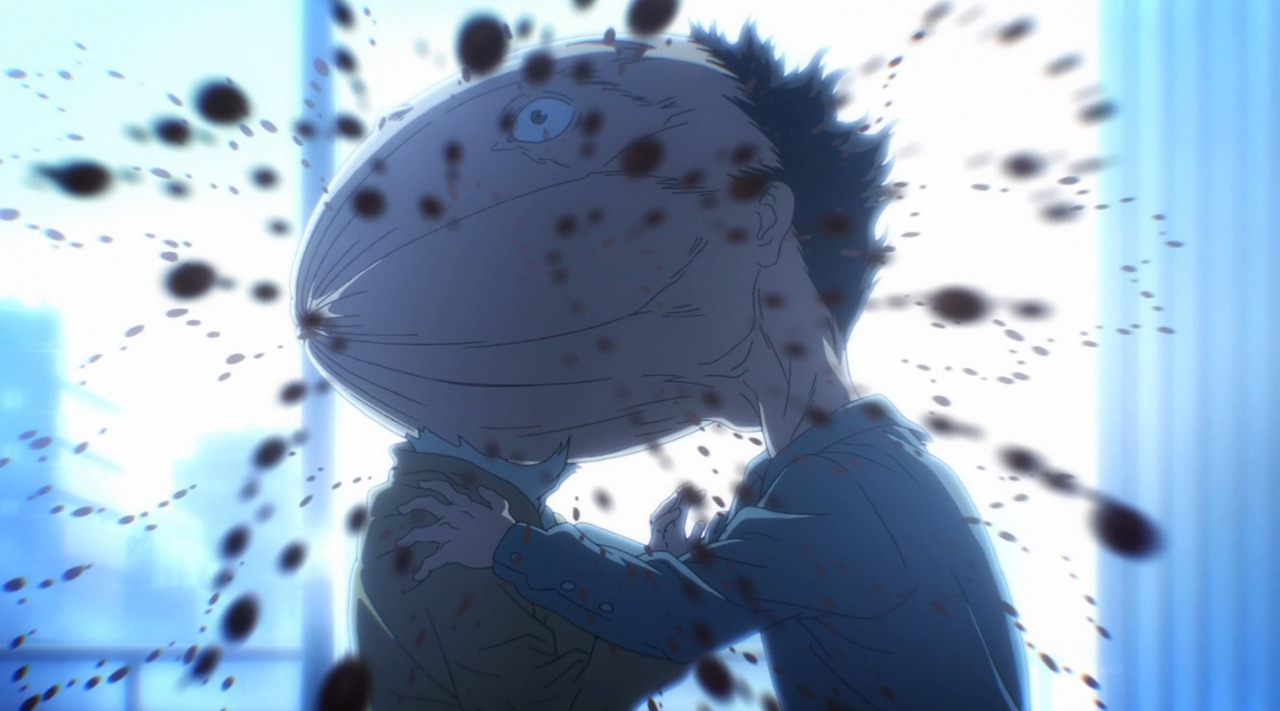
Nope, not censored! Now let's all go laugh at Terraformars' shitty black bars...after we watch this, of course.
One day, someone on earth had a sudden thought: “Life must be protected.” And, as if to answer that wish, small spores suddenly fluttered down from the sky over the nation of Japan. Nobody knows where they came from. They could be life forms that traveled across the stars, or they could be a new species of life that grew up innocuously in our own backyard. One thing that is certain, though, is that they are hungry. Weak in their own natural state, these creatures infect the bodies of unsuspecting victims, and take over their bodies. They are sort of like the classic monster, The Thing, in a way. And like The Thing, they can distort their bodies into grotesque, horrifying forms, equipped with deadly weapons to cut down any prey or opposition. Now these monsters walk amongst us, looking and acting just like us, hunting for fresh flesh to feed on from their host species. They are the Parasytes, among the greatest horror monsters to ever come out of the medium of manga, and this is the story of how a young man attempts to fight these creatures off, protect those he cares about, while grappling with a personal transformation of his own, one that threatens his very identity.
Though, I shouldn’t need to tell you any of that. I mean, come on, you have to have heard of Parasyte before this. It’s one of the best and most highly regarded manga ever made; a thought provoking action-horror story with strong environmental themes and social commentary. It’s almost surprising that it’s taken so long for it to get an anime, but perhaps rights issues got in the way. Parasyte was so popular back in the day that it attracted the attention of many people in Hollywood who wanted to turn it into a live-action film, including, at one point, James Cameron. Of course, like most of Hollywood’s attempts to turn anime and manga based properties into films, production on the film has been stalled for years. The last anyone heard of the effort was that Jim Henson studios was producing it, and that was a decade ago. So, like most long-rumored upcoming films based on anime/manga series, such as Akira, Death Note, and Battle Angel Alita, it’s probably never going to get made. In fact, I’m pretty sure whoever had the rights to the film let them expire, and that allowed Toho to get them, and produce two live-action films based on the series set to come out later this year. And, of course, that’s what inspired Madhouse to pick up the rights for an anime adaptation of the property, to coincide with the film’s release. Corporate synergy for the win, yeah!
If you can’t tell by now, let me make this clear: Parasyte is a big-name property. It might not be one of those massive commercial phenomenons like a lot of long-running shonen series or Type Moon’s Fate, but it is a classic manga that is still well-beloved in it’s home country and gained widespread recognition from both manga fans and important movie producers overseas. So, there was a lot for this anime to live up to. Considering it’s production was announced at the same time the movies were, which was a year ago, Madhouse clearly wanted to put in a lot of time and effort into making this a great series worthy of it’s pedigree. There were a lot of doubts from fans of the manga in the year leading up to this. Many were worried the graphic content would be heavily censored, or took issue with the new character designs, etc. And it’s not hard to see why a lot of fans were both excited and anxious about this adaption. Parasyte is a series that, handled just right, could be an amazing anime if Madhouse succeeded at capturing every facet that makes it the classic that it is just right. And boy howdy, am I sure glad to say that they’ve indeed succeeded, and then some.
This first episode starts with a bang and hits all the right notes immediately after. Everything is well-paced, throwing a lot of information out but doing it in a palatable way that keeps enjoyment and interest high, and accomplishes a lot in 24 minutes. This is somewhat to be expected, since they are adapting a fairly dense 10-volume long manga into a mere two-cours, 24 episodes long anime, but if you haven’t read the manga you probably wouldn’t even be able to tell. All the characters are established and well-characterized, with early hints at character arcs to come. Those who complained about the changed character designs should soon forget their gripes, because they work brilliantly in motion, and allow for far more expressive animation than the more stiff designs of the manga could hope too. The animation itself is fantastically rendered, wonderfully expressive, fluid, and energetic, allowing for a multi-faceted range from subtle emotional scenes to awesomely-rendered action sequences. The color design and direction allows for beautifully looking scenes that get across the emotion and mood of the moment remarkably well, allowing the body horror moments in particular to stand out as truly unnerving and grotesque. Speaking of, in case you couldn’t tell from the picture, the series hasn’t been censored in the slightest! Fuck yeah!
Not only does the show look great, but it also sounds pretty good as well. The sound design is excellent, working to set the mood and tone of scenes very well, and really fleshing out the more horror-based ones. The voice acting is perfect and top-notch, with an extra special mention to Aya Hirano in particular, whose portrayal of Migi in a hilariously deadpan voice does wonders in bringing the character to life. Madhouse did not waste any of the time they spent working on this show, and it shows, because the production values are top notch through and through. The one gripe I have with is the OST, which uses some dub-step and electronic sounding tracks that are either not used effectively or don’t properly fit the scene or the kind of series Parasyte is, in general, but this is generally not much of a problem. Except for the opening, which frankly sounds like shit and makes my ears bleed, but it’s a song from Fear, And Loathing in Las Vegas, so I expected nothing less. The ending theme is significantly more ear-pleasing, though, and reflects the more subdued, human element of the series very well.
Overall, Parasyte -the maxim- is a rousing success; a beautifully looking, well-executed and animated adaption of the famed classic that fires on all cylinders all the way through. If you’re like me and are a huge fan of the manga, you might be able to nitpick and lament at some changes to the story and the reordering of certain events, and might be particularly disappointed at the removal of the iconic dick-hand scene (google it), but overall these are just frivolous nitpicks and nothing more. This is a quality adaption of the source material, and one of the best-made, and perhaps the best, anime to come out of this season, if not the year. And I can assure you, it will only get better from here. One of the biggest reasons the Parasyte manga has persevered in popularity decades after it’s conclusion is because, like the best works of anything in any medium, it is about something more than itself. It asks timeless philosophical questions, and is a well-written, often funny, often tragic character-driven story beginning to end. I’m not going to spoil exactly what those questions are, or what answers are reached. But one thing I will say, is that for all the focus it puts on it’s titular monsters, Parasyte is really a story about humanity. And I, for one, can’t wait to fall in love with it all over again. I think you will too. — Cartoon X
Psycho-Pass, Season 2
The Sibyl System’s governed land returns, where people are arrested not simply for crimes, but for the mental possibility of committing such crimes. The concepts of right and wrong are replaced with a system’s intolerance for mental instability. Cops have their morals bent over backwards to uphold an oppressive regime, and the only people who can rebel often use terrorist aims to get their point across. One can wonder how any light can shine in this world, except for Akane Tsunemori and her endeavor to bring justice not through force but through altruism. She may have few sympathizers, and the other cops might think she’s wrong, but she still has enough energy to fight back against neverending corruption.
And in the year and a half since taking that stand, crime still wreaks havoc as usual. The premiere throws us back into Akane’s world without full knowledge as to what’s changed and what’s stayed the same. New cops are around, and criminals are now given more lenience than previously, but the Sibyl System still stands. I really like the finale of last season because while the system doesn’t get brought down, Akane’s inability to be broken by the show’s trauma could make you believe that she could on day revolutionize society. While the circumstances were bleak, the season ended on a hopeful note.
That hope seems to have diminished in the interregnum, but hasn’t completely disappeared. A lot of this episode had a “back to basics” feel, with a case of the week that hued more to the procedurals of the first half of last season. I’m hoping things escalate from there, especially given this season’s shorter length. There’s also the new characters introduced like Togane and Hinakawa, where they could be good for the dynamic or get wasted like Kagari and Yayoi were. Frankly, this episode gave me a sense of joy over seeing the series explored again and concern over how they can expand on what was already a very good story. And given the change in screenwriters, those feelings are running thick. — Bloody Marquis
Ronja Rövardotter (Sanzoku no Musume Ronja)
If this season is caught in a time loop then Ronja Rövardotter must be the latest installment of House Foods World Masterpiece Theater. Its an adaptation of a 1981 novel by Astrid “Pippi Longstocking” Lindgren, arguably the most famous Swedish writer who didn’t write books about Girls With Dragon Tatoos. It sports a theme song that sounds like it was recorded on a cheap ass Casio in 1984. Hell its even directed by Miyazaki!…no not Hayao, his son nobody likes for some reason. Yes this truly is a show out of time albeit with one small difference…its almost full 3D CGI.
Yes for their first ever full-length TV series (I know, it took them HOW long?), Studio Ghibli decided to collaborate with Polygon Pictures, the company that produced Knights of Sidonia, which is still probably the best show of 2014, last spring. All the characters in the show are cel-shaded models, based off designs from the guy who did Spirited Away. The backgrounds which were done by Ghibli themselves however remain flat and hand painted and they look eyepoppingly gorgeous, especially in HD. Now, you might think there would be some disconnect between 3D models on hand painted backdrops and occasionally there is. A few side on shots look a bit off as if the cgi was being squished by two pieces of glass, but for the most part it works remarkably well, and I just couldn’t help but stare at it.
…Then again, I really had no choice but to stare at it because I ended up watching a raw. Yes its literally been about four days since Ronja’s double length premiere aired on NHK and nobody wants to sub it. While I’m not too surprised considering how long it took to get episodes of Sidonia out here, its actually kinda sad considering Ghibli. That being said, the plot really isn’t that hard to follow considering the language barrier. Its a slow paced story that builds up to a classic Ghibli “fledgling leaves the nest” scene. You know, like the kind that started off Kiki’s Delivery Service. It doesn’t drag persay but the fact that you’re essentially watching two episodes of the show glued together does draw attention to itself pretty quickly. Nevertheless I found Ronja to still convey a sense of sweetness and air, and it would make a very good chaser for something as horrible and asinine as Cross Ange. That is…if somebody would SUB IT. — Lord Dalek
Addendum!
Oh hey Koi stepped up and subbed Ronja!…and it only took FIVE DAYS. And while I found my first viewing of the show to be moderately enjoyable, I can now say that I really like Ronja. There’s a gentle humor in the script that isn’t obvious because of the language barrier and I found myself smiling at the results. Maybe not for everyone, but for this grumpy old Dalek, its a keeper.
Shirobako
P.A. Works is a studio with immense talent wasted on boring shows – Glasslip, Angel Beats!, Red Data Girl and others. The Eccentric Family, Another and Canaan came from good or reliable sources and made for interesting, enjoyable watches. Shirobako, like Nagi-Asu: A Lull in the Sea, had an interesting concept that could have be executed well – if it wasn’t deathly boring.
The Eccentric Family, Canaan and Another all had boons thanks to solid source material that laid out the pace of the show from episode one. Shirobako, on the other hand, does not have that boon – and even without that boon, a show should keep its audience enthralled or even mildly interested in the medium they are watching – something Shirobako fails at.
I will admit, the opening scene allowed an interesting change from most anime as of late: the show does not take place in highschool, only the opening scene did. The story itself concerns the adventures of five girls after their highschool graduation, living their own lives in society. The story of this episode is the tale of Aoi Miyamura, an animator who works at Munashiro Animation – a reference to the long-dead studio Mushi Pro – and her work on an anime named Exodus. It chronicles stress, the attitudes at animation studios, friendship and lots and lots of curry.
This show could be great if P.A. Works didn’t make it so monotone. The show doesn’t tell us a lot about Aoi, or anyone she works with. We are plunged into her world with little information about her, and the show doesn’t allow us to emote to Aoi because we don’t know her well enough yet. We don’t feel connected to the story because we know nothing about it. When a character faints at the end of the episode, it feels forced, because we don’t know them well at all. Forced drama is the worst kind of drama, and it is the kind of drama P.A. Works likes to suffocate most of their works in – see Hanasaku Iroha.
The character designs look like typical P.A. Works fodder. It is baffling how this show employs a completely different character designer – Ponkan8 – and still makes it look like the bastard child of Glasslip. The animation itself is decent, and although 2014’s anime has an obsession with shitty CG use, the CG in this episode was pretty decent for a TV anime. The car chase when the show switches to its main setting had an effective use of soundtrack dissonance – idol songs really do put you off car races.
This show really does have promise, exploring how anime itself is made and produced. If the show moves out of its growing pain phase, it could be somewhat decent by normal anime standards and amazing by P.A. Works standards. — Mahobako
Second Opinion!
The tale of 5 young girls as they aspire for success in Japanese animation production.begins this week. It is a promise made on donuts. The group’s first feature is shown at a school festival, but then bam! time skip to 2.5 years later as Aoi, one of the girls is a production assistant for an animation studio. It has a brief turn into Initial D for some reason and then Animation Runner Kuromi as Aoi is a production runner, making sure to pick up animation work by a home worker. The moment that really cemented this series for me was the scene of the staff watching the very first episode of their anime series. It is truly a sight seeing those that work on anime watching their stuff live on TV. One of her friends Ema also works at the same studio as a rookie key animator Animation production is truly a stressful job full of trials and troubles, it kind of puts my day job to shame nearly.
But yeah I like this show quite a lot. This show had a lot of high expectations, and thankfully it stood up to them. This is essentially Animation Runner Kuromi (that OVA you might have heard) or the final episode of the Golden Boy OVA done in series form. Another thing I took away from this is that this is clearly a project of passion and love, thanks in part by the director Tsutomo Mizushima (Another, Girls und Panzer, Genshiken, Joshiraku, Squid Girl, etc) anime comedy writer Michiko Yokote and staff at PA Works,which while good with most of their other shows, I think with this show have hit their stride. Add to that the fact that this show may possible be 2-cour, puts that rare big grin on my face. — The Eclectic Dude
Trinity Seven
When the first episode of your series opens with the main character enthusiastically groping his cousin for nearly a minute and then refusing to apologize for it afterward, you’re setting an overwhelming precedent that it’s going to be terrible. While Trinity Seven has a couple of potentially interesting things going for it – and is certainly far from the worst show to air this season – this assumption largely rings true throughout the rest of its premiere. The initial premise is actually pretty neat: a cataclysm happens that disintegrates the majority of the world’s population while simultaneously leaving its environment barren and man-made structures in ruins, but Arata Kasuga, the protagonist, is blissfully unaware of this due to a dark magic spell he inadvertently cast with a potentially evil grimoire. However, something is clearly rotten in Denmark (err, Japan), as the sun has suddenly turned into a gaping black maw, and his cousin, Hijiri, has started implying that she’s hungry like the wolf.
The entire aforementioned storyline is completely resolved by the halfway point. Arata then goes on to join a magic academy (yaaaaaay) and make small talk with his fellow students about their breasts. While the early universe-establishing moments were badly executed, with such concepts as pacing and tension being almost nonexistent, they had undeniable potential and in some ways reminded me of the excellent video game Nier. But no, instead Trinity Seven‘s setup exists only to pave the way for this season’s inevitable installment in the beloved “Harry Potter with tits” sub-genre of anime. It almost feels like the writer initially had an original idea for a fantasy series, but after a few hours of work decided that it wouldn’t sell enough copies, so he scrapped everything after the prologue and replaced it with something else.
Make no mistake, from beginning to end, there is absolutely nothing good about this episode (aside from the fantastic opening and ending themes), but I’d still rather watch something that tries to be original and fails due to poor writing than something that resembles countless other anime and, well, still fails due to poor writing. Not only is Trinity Seven bad at successfully telling a story, it’s also bad at comedy and bad at crafting interesting characters. The second half of this episode actually made my eyes glaze over on multiple occasions from boredom; not only was it doing nothing new or exciting, it also failed at presenting old ideas in a fresh or unique way. The immature jokes, archetypical characters, bland setting, halfhearted animation… I’ve seen it all before. It’s not particularly awful, but there’s just nothing here for me to care about.
Also, it’s kind of weird how girls are apparently better at magic in the world of Trinity Seven because they’re “more emotional.” Huh. That’s a contrived and potentially eyebrow-raising explanation if I’ve ever heard one. Also, the main character seems to love sexually harassing women, so, uh, there might be something to read between the lines here about the original author. That said, I think I’d be more annoyed by these things if this anime actually merited any sort of intellectual response, but instead I can just feel myself falling asleep at the mere prospect of watching more Trinity Seven. Good night, ladies and gentlemen. — Foggle
Your Lie In April
Your Lie In April is a difficult one to judge. While there are definitely things I liked about this episode, I also ended up cringing a lot throughout – sometimes even at the aspects I enjoyed. For instance, I found myself taking a liking to the goofy characters, but I could hardly tolerate the show’s sense of humor itself; the more subdued antics are amusing, but when the episode treads into full-on comedy mode, it loses me immediately. Compare the scene where Tsubaki gets Kousei’s attention by hitting him with a baseball to the one where Kaori mercilessly beats him with musical instruments: the former is silly, but accurate to how middle schoolers behave in real life, while the latter is just ridiculous and unfunny. In that regard, this is one of the few anime that I think would truly benefit from employing a greater sense of realism.
The art style is very nice. Character faces can look a bit weird at times, but this series sure is pretty on the whole. The colors also seem to become increasingly more vibrant as it trots along, adding a nice sense of parallelism between a key theme of the story and the gorgeous technical aspect; in fact, this might be the first truly impressive production I’ve seen from A-1 Pictures since AnoHana. Unfortunately, much like that series, Your Lie In April at times seems like it’s trying too hard to evoke an emotional response from the viewer. While I can’t say I didn’t feel something for Kousei during the flashback about his mother, the framing of certain scenes (including that one) and his incredibly depressing narration throughout the rest of the episode often make the drama feel fake and manufactured – it’s like the writer is begging you to care about the main character instead of just letting it come naturally. Oddly enough, I found myself liking Tsubaki a lot more than any of the other cast members, even though her primary role so far seems to just be “obligatory childhood friend.” This is probably because she was the only character presented to the audience in a way that felt relatively natural.
This first episode certainly has its problems, but I think it also shows a lot of potential. If the folks behind this series can manage to craft a believable romance while also toning down the more garish comedic and dramatic moments, I think A-1 Pictures may have a winner on their hands with Your Lie In April. However, no anime can coast by on beautiful artwork alone, and that seems to be the only real draw so far. I’m hopeful that this one will turn out well in the end, but I’ll be remaining cautiously optimistic for the next few weeks at the very least. — Foggle
